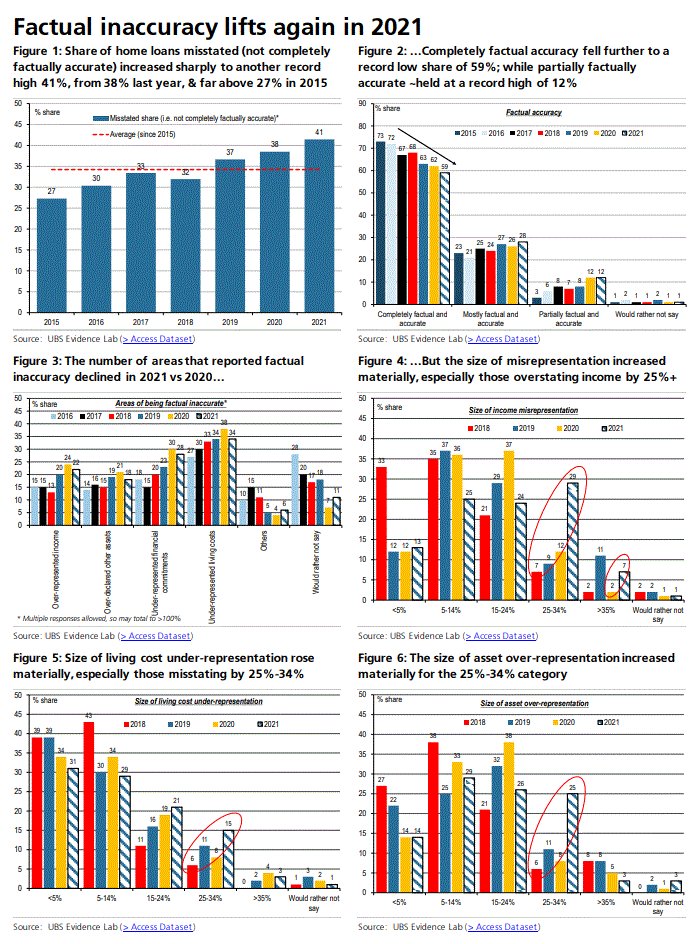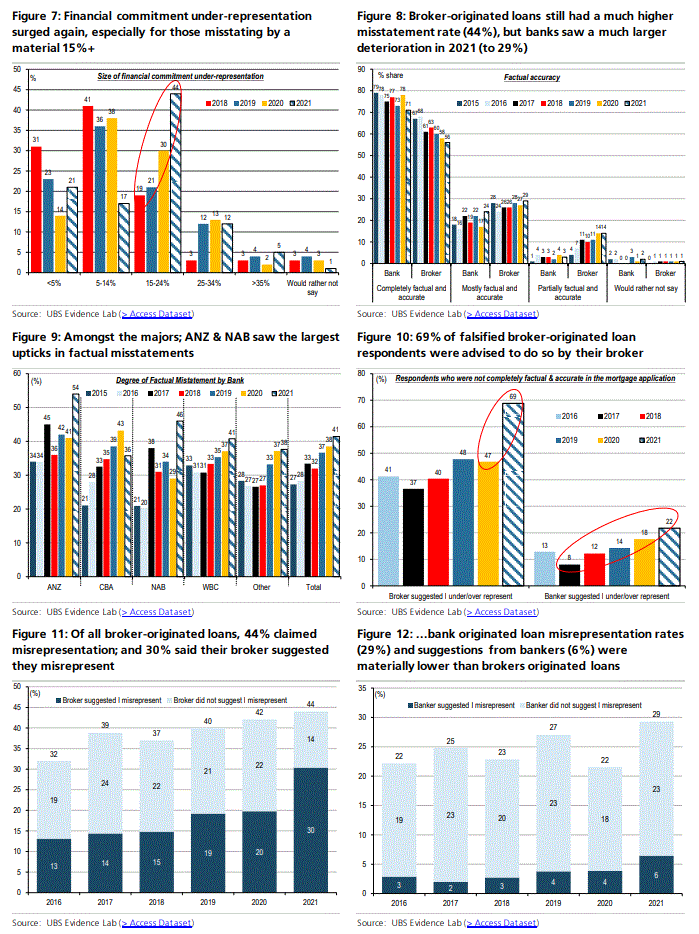Shortening odds for the next Banking Royal Commission. UBS’s excellent George Tharenou:
UBS mortgage survey implies material deterioration in Aussie loan standards
UBS Evidence Lab surveyed ~900 Australians who took out a mortgage in the last year – conducted from 21 June to 5 July, at the start of lockdowns in over half of Australia (which are still ongoing, but are expected to ease slowly from October). The 2021 vintage is the 7th year. Overall, it suggests a material deterioration of lending standards. The share of home loans that are misstated (i.e. not completely factually accurate) increased sharply to another record high of 41%, up from 38% last year, & far above 27% in 2015. Positively, there was a fall in the number of areas of misstatement. However, in contrast, the size/magnitude of misstatement lifted materially, with a much larger over-statement of income (especially by 25%-34%) and assets; and a greater under-statement of financial commitments and living costs (especially by 25%-34%).
Large rise in ease of applications; but mixed results on verification
Overall, there was a large rise in the ease of application. That said, documentation and verification had a large increase in both “much less” and “much more” answers, suggesting lenders are making a more targeted risk-assessment. Meanwhile, mortgage rejections were ~steady. However, the time for approval lengthened again; albeit this is more likely due to the record volume of loans, rather than tighter lending standards.
Income up & expected to rise; & savings high, but only 10% plan to consume
Positively, 44% report household income is above the pre-COVID level, and 55% expect income to improve in the next year. Indeed, 63% of respondents have saved extra since COVID. But, we were surprised that only 10% are planning to consume all of this, with most expecting to take a long time to spend. Indeed, savings intentions vs 3 months ago are relatively high, with 41% planning to save more & only 9% save less.
Q2 APRA data showed falls in IO & high-LVR loans, but key is spike in high DTI
Separate APRA data showed higher risk home loans largely declined (i.e. improved) q/q in Q2, with a fall in the share of Interest-Only (to 17.4%, lowest since 2018), high-LVR ≥80% (38.8% after 41.2%), low-documentation and/or outside serviceability (2.9%), & investors (27.6%). This was surprising given the contrast to our EL data. However, we think the ‘truer’ read of the rising leverage and risk is the record rise in the share of very-high ≥6x DTI loans (+2.7%pts to 21.5%). Indeed, ABS data shows average owneroccupier loan size jumped by 23%y/y in July; while EL data shows a requirement for a guarantor increased to a record 36% share. So amid dwelling prices booming by 18.3% y/y (the fastest since 1989), we think that borrowers are ‘chasing the market’ and stretching towards their capacity limit, to be able to qualify for home loans.
Macro-pru tightening still not seen (for now); but also not priced into equities
In a ‘normal’ environment this would see a repeat of the policy response of macroprudential tightening & RBA rate hikes. Indeed, booming house prices recently led to a jump in credit growth, & our data suggests material deterioration in lending standards. But, during this cycle the RBA remains remarkably dovish, saying monetary policy is not a tool to address house prices, and only sustained 10% credit growth is problematic enough to consider intervention. Post our note, APRA Chair Byers reiterated ‘there is no obvious poor quality lending’. Therefore, as the economy rebounds – but there are still no RBA rate hikes – we think it’s likely that home prices and credit growth remain strong. Hence, amid ongoing lockdown, & uncertainty about the economic recovery, it’s still unlikely there will be any tightening before May-22. We expect dwelling prices to boom 20% this year, & at least 5% next year, albeit closer to 10% is likely (was ~5%). Housing credit growth should accelerate to >7% y/y, & total credit near 6%.



